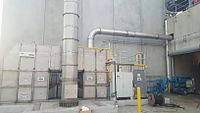
Photo from wikipedia
Abstract This paper deals with the economic analysis of a trigeneration system proposed for buildings. Firstly, a general feasibility analysis is presented for power and heating (P&H), power and cooling… Click to show full abstract
Abstract This paper deals with the economic analysis of a trigeneration system proposed for buildings. Firstly, a general feasibility analysis is presented for power and heating (P&H), power and cooling (P&C) and power, heating and cooling (PH&C) modes of operation using economic indices payback period (PBP) and net present value (NPV). Results show that the total cost of investment varies from as high as US$ 1500/kW th to as low as US$ 13/kW th depending on the mode and heating/cooling capacities. Accordingly, PBP varies from 2 months to 11 years while NPV ranges from – 5 to 6 million US$. Later, the system’s feasibility is assessed for a case of residential buildings situated near the power plant for which required domestic water heating is estimated to be 279 kWh th /capita per annum while the demand for space heating and cooling is 64 and 109 kWh th /m 2 floor area, respectively. The parametric results show that NPV tends to increase and PBP tends to decrease with rising fuel prices and load factors while decrease in interest and inflation rates and natural gas use in conventional heating. The trigeneration scheme is favorable in P&H- and PH&C-modes while for P&C-mode it could only be accepted for the best-case scenario.
Journal Title: Sustainable Cities and Society
Year Published: 2017
Link to full text (if available)
Share on Social Media: Sign Up to like & get
recommendations!